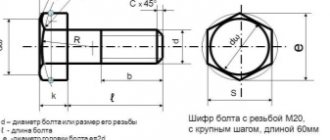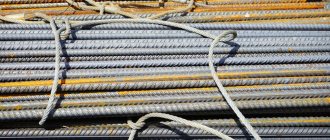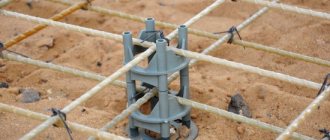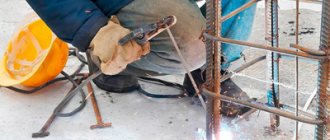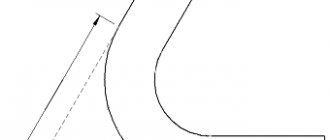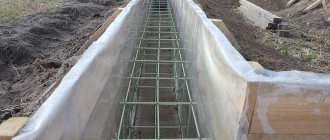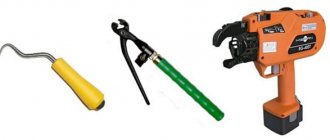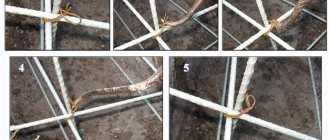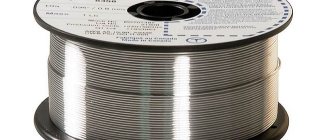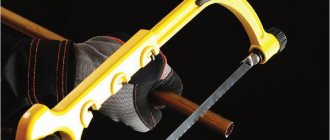Anchor bolts are calculated for static and dynamic loads. The magnitude, direction and nature of the operating loads from the equipment on the bolts must be indicated in the assignment for designing foundations for the equipment.
The steel rating of design bolts operated at design winter outside air temperatures up to minus 65°C inclusive must be assigned in accordance with the instructions in Table. 1.
Note. Bolts may be made from other grades of steel, the mechanical properties of which are not lower than the properties of steel grades indicated in Table. 1.
In all cases, structural bolts may be made from steel grade VSt3kp2 in accordance with GOST 380.
The calculated tensile strength of bolt metal R should be taken according to table. 2
All bolts must be tightened to the pre-tightening value F, which for static loads should be taken equal to: f = 0.75 R, for dynamic loads F = 1.1 R, where P is the design load acting on the bolt.
For building structures (steel columns of buildings, etc.), bolts can be tightened with standard hand tools with maximum force (all the way) on the bolt.
The cross-sectional area of the bolts (by thread) should be determined from the strength condition using the formula:
where ko = 1.35 - for dynamic loads; ko = 1.05 - for static loads.
For removable bolts with anchor plates installed freely in a pipe, the coefficient ko for dynamic loads is taken equal to 1.15.
Under the action of dynamic loads, the cross-section of the bolts, calculated using formula (1), should be checked for endurance using the formula:
where x is the load factor taken according to the table. 3, depending on the bolt design; m is a coefficient taking into account the scale factor, taken according to the table. 4, depending on the bolt diameter; a is a coefficient taking into account the number of loading cycles, taken according to the table. 5.
Table 3 (* The embedment depth for bolts with a diameter of less than 16 mm is given in brackets. * The values of the static load coefficient k are given in brackets.)
Table 4
Table 5
When calculating fastenings of building structures, the pre-tightening force and cross-sectional area of the bolts should be determined as for static loads, unless there are special instructions in the project.
8.2. Increasing the mass and rigidity of foundations when strengthening them (Part 9)
During the operation of centrifugal smoke exhausters in the recirculation of gases of the GD-26×2 brand to turbine units with a capacity of 800 thousand kW, increased vibrations of the bearings of the smoke exhausters and the bearings of their engines arose.
As a result, bearing failures occurred. In addition, vertical cracks with an opening width of 0.3-2 mm appeared in the body of the foundations of the smoke exhausters, which ran from the upper edge of the foundation to the ground surface and were located in the places where the machine was attached to the foundation (Fig. 8.12, a). The reinforced concrete massive foundations of smoke exhausters are made in the form of a single monolithic block with the necessary ledges and recesses. The upper part of the foundations was significantly weakened by the wells of anchor bolts, while the distance from the edge of the wells to the edge of the foundations in the places where bearings and smoke exhausters were attached was less than required. The measurement results and the obtained vibration modes (Fig. 8.12, b) of the examined smoke exhauster foundations showed that the upper part of the foundations is not a single massif, but is divided into separate conglomerates by through cracks.
The amplitude of horizontal vibrations of the upper edge of the foundation reached 0.07 mm, and the amplitude of the frame and bearing of the smoke exhauster - 0.25 mm, which indicated the absence of a rigid connection between the machine and the foundation. The reasons for this were a decrease in the rigidity of fastening anchor bolts in the foundation body due to the presence of cracks and damage to the integrity of its upper structure, as well as weakening of the tightening of anchor bolts due to the accumulation of plastic deformations in the bolts under the combined action of dynamic loads and high temperatures that arose due to insufficient thermal insulation cars. The latter also contributed to the occurrence of additional temperature deformations in the upper part of the foundation.
The condition of the foundations required immediate strengthening, which was carried out as follows. The upper structure, weakened by recesses and cracks, was reinforced to its entire height with a reinforced concrete belt-cage 0.5 m thick (Fig. 8.12, c, d), which ensured the foundation rigidity required by calculation, as well as a reliable connection between the machine and the foundation due to an increase in the rigidity of the upper part of the foundation in the places where the anchor bolts are attached. Existing cracks were cemented with an expanding cement mortar and filled with epoxy resin where the anchor bolt was installed. To ensure reliable tightening of the fastening nuts, an elastic element was introduced into the anchor bolt tightening unit. At the same time, it was recommended to strengthen the thermal insulation and ensure a gap between its surface and the foundation elements of at least 100 mm. The frame of the cage (class A-II steel, with a diameter of 12 and 8 mm, with a pitch of 200 mm, was connected to the foundation reinforcement by welding using separate rods at the level of the foundation grids. The cage was concreted with concrete grade M 300.
The work examines cases of strengthening individual structural elements of frame prefabricated monolithic foundations of turbine units by increasing the rigidity of these elements operating in the frequency range close to the resonant one. The increase was achieved by increasing the thickness of the concrete sections of the elements (with the addition of reinforcement according to calculation), as well as by introducing additional metal connections.
Strengthening the foundations of impact machines is mostly carried out during reconstruction in connection with the installation of more powerful equipment on the foundations or in case of significant vibrations of buildings. Cases of strengthening such foundations caused by errors in their design or construction are described in the works.
Strengthening the foundations of impact machines (such as forging and stamping hammers, impact piledrivers) is mainly limited to the reconstruction of the hammer part. As an example (data from M.I. Zabylin), let us consider strengthening the foundation of a headframe, the underframe part of which (Fig. 8.13) in the upper part was destroyed during operation into separate conglomerators, and the reinforcing mesh was torn. Before strengthening, the conglomerators were partially removed. In drilled vertical holes with a diameter of 40 mm, reinforcing bars with a diameter of 36 mm of class A-II were installed using epoxy glue to a depth of about 1 m. A reinforcement mesh of concrete made of concrete grade M 300 was attached to these bars to the height of the remote part of the destroyed concrete.
Types of anchor bolts
First of all, anchor fasteners differ in their mode of action. They are:
- Chemical. Such products are a capsule with glue, which is placed in the hole. As soon as the anchor begins to screw into the wall or any other surface, the capsule is crushed and the glue polymerizes, securely fixing the fastener. The chemical anchor bolt for concrete is indispensable for hollow slabs. However, such products are expensive, so they are not so popular. Another disadvantage is that after installing the anchor you will have to wait for some time until the glue “sets”.
- Mechanical. Bolts of this type are attached due to the expansion force when screwing the products into the concrete mass. Fasteners of this type are cheaper and are used much more often.
In turn, a mechanical anchor bolt can be:
Klinov
The wedge anchor (KA) is attached thanks to a special wedge located at the inner end of its sleeve. When hammered, the fastener expands the sleeve, thanks to which the element is securely fixed.
Also on sale are wedge-type anchor bolts with a nut, in which wedging is carried out thanks to a separate rod. After fixing the fastener, it is removed from the hole, and a special pin is installed in its place.
The anchor bolt with nut can be electrogalvanized (KA), acid-resistant (KAN) or hot-dip galvanized (KAK). Fasteners of this type also include a stainless steel screw anchor (RAR).
Hammerable
Driven-in anchors are characterized by a simple design - they do not have a wedge. Fastening is carried out thanks to the special edges of the sleeve, made of softer metal, which are deformed during the process of driving the sleeve.
To secure such an anchor, you do not need to measure the drilling location with millimeter precision; deviations in diameter and depth are also allowed.
This type of anchor is suitable for brickwork, natural stone and monolithic concrete surfaces.
Expandable
An expanding anchor (or “butterfly”) is used for thin-walled and sheet materials. The design of such a fastening element is distinguished by the presence of slots located in the middle of the sleeve. In the process of tightening the screw, its back part begins to move along the thread, and the sleeve is deformed, thereby forming peculiar petals that press the anchor (these elements are very clearly visible in the photo).
The main advantage of the “butterfly” is that the product can be dismantled at any time. To do this, you do not have to perform diamond cutting of concrete and other labor-intensive work.
“Butterfly” is suitable for plasterboard, plastic and fiberboard. If there are metal elements (reinforcement) in the wall, then before installing anchors in concrete, it is necessary to remove the reinforcing particles.
spacer
Expansion anchor bolts for concrete are considered the most popular due to their ease of use. When installing them, it is not necessary to strictly adhere to tolerances, depth and diameter of the hole. This device operates on the principle of collet expansion of the sleeve by screwing a cone-shaped sleeve into it.
There is also a double-expansion anchor for concrete, which contains two moving couplings at once. Thanks to this “structure” the product is characterized by increased fastening strength.
These types of anchors are used only for concrete and solid brick.
In addition, special products equipped with hooks and rings can be found on sale. The anchor loop is very convenient for installing lighting fixtures and communications.
For the production of fastening anchors, stainless steel coated with a layer of anti-corrosion compound is most often used. Products can be of different sizes.
Anchor bolt with nut - weight, dimensions: what does GOST tell us?
Since all fasteners are complex installation products, they all have appropriate technical documentation. It is from such documents that we can find out technical parameters if necessary. For example, when choosing this or that fastener, we want to know whether the anchor fastening will withstand a weight of 100 kilograms or not. Thanks to the fact that there is documentation, we will receive an answer to our question.
The smallest anchor, whose dimensions are 5x6.5x18 mm, according to the manufacturer's stated characteristics, is capable of withstanding a pullout load of up to 800 kgf.
To make it clearer, kgf is the designation of kilogram/force, where the calculation takes into account the mass of one kilogram and the force with which this kilogram exerts pressure on the scale. Further calculations are quite simple, 1 kgf is equal to approximately one kilogram of any object, based on this, such an anchor will support a product weighing 800 kilograms.
Also, absolutely any bolt has a corresponding GOST, which divides all fastening structures into varieties according to their ability to withstand a certain load, the size and diameter of the fastening element. On large construction sites, such documentation helps in the selection of fastening elements and the purchase of appropriate materials.
Basics of the principle of connecting anchors
Anchor connectors are held inside the foundations due to the influence of various forces - emphasis, gluing, friction, but they arise when the monolith interacts with the connection.
During the spacer of the expanding collet, similar forces arise; the stop is distributed over the bolt, where it is compensated by internal resistance, which contradicts the breaking force.
Bonding eliminates the pressure arising from shear stress at the point of contact between the anchor and the concrete.
The choice of fasteners is carried out based on the expected load on one point. The features of the base are taken into account to find the desired type of fastening. An important factor is the main characteristics of the foundation: type, degree of strength, structure.
The size of the anchor system used is selected based on the physical parameters of the structure being installed. The larger and heavier the structure, the longer and thicker the bolts should be.
Then, the optimal distance between the bolts is calculated, according to the weight, dimensions of the attached structure or technical support.
Recommendations for the correct installation of anchors can be viewed in the following video:
Installation
Before proceeding with the installation of this type of fastening, it is necessary to calculate the required bolts according to the design documentation. This is done to determine their performance characteristics. It is worth taking into account the distance from the edge of the foundation, as well as the depth of the hole. Anchor bolts are held in place due to such features as gluing, emphasis and friction. As for the stop, this is the load that the fastener takes on and compensates due to its design characteristics. The load is provided by friction. Well, gluing is a compensation of these loads thanks to “tangential stresses”.
But it is also worth focusing your attention on the fact that the size of the anchor along with the embedment depth should not be greater than the height of the foundation itself. This is very important, otherwise, when the bolt itself is tightened, the fixation will fail. You will not achieve the required reliability of such fastening. The connection to the slab must be rigid and durable.
Before installing the bolt into the foundation, you need to perform a visual inspection of it for possible defects in the structure.
Installing anchors is not a complicated procedure. You can do it yourself without involving a team of professionals.
However, to do this you need to adhere to a number of basic rules.
- Thoroughly study the construction site plan and determine the exact locations for installing anchor bolts.
- Control the depth of immersion of this fastening into the already formed foundation. It should not be greater than its thickness.
- Be sure to consider the distance between adjacent fasteners. The calculation is quite simple: these are two values of the deepest embedment depth.
- Foundation bolts must be strictly vertical.
- Formation of a block of this type of fastening. After the concrete has completely dried, you need to fasten all the ends of the bolts using an iron plate or board with pre-drilled holes. Thanks to this, the reliability of the entire structure will be high.
- If you are attaching anchors before pouring the foundation, then it is also worth calculating in advance their most accurate location according to the building design.
Machine foundation price
If the machine is large and heavy enough, the cost of construction work will be quite significant. It is best to start building the foundation of the machine immediately after concluding a contract for the supply of the machine, by requesting a foundation drawing from the manufacturer. In this case, as a rule, there are 4-8 months to select an experienced work contractor, agree on an estimate and a contract for the manufacture of the foundation
It is important not to delay the start of work until the machine is manufactured. Otherwise, you will have to postpone the start of installation, commissioning and commissioning for the period of approval, production and hardening of the foundation
As a result, this may result in downtime of expensive equipment.
Types of foundation structures
- Baseless base of slab type, dampening vibration with its mass. Such foundations can be poured into formwork only on the first floor of the workshop. Such a design will cost a significant amount, since the maximum amount of building material is spent on the construction of a solid slab-type base. However, the largest machines and mechanisms are mounted only on such foundations.
- Frame foundation. Basement base-floor, mounted on the second floor and above. Such a foundation dampens vibration, transmitting vibrations to the frame of the workshop itself (through contact with the interfloor ceiling). In essence, it is the same slab, only not poured, but assembled from reinforced concrete products installed on the interfloor floor beams. Such a base can only withstand static loads or vibration with minimal amplitude.
- Wall foundation, developing the idea of a strip foundation. The load-bearing load and vibration in this case are taken by load-bearing walls or internal partitions. As a rule, such foundations are placed under mechanisms located on the second floor of the workshop.
- Frame type bases (with beam grillage). This design withstands high-frequency vibration. Therefore, in most cases, foundations for impact mechanisms have a “frame” design. After all, dampers can be installed in the frame supports to dampen vibration.
How to install
First of all, you should pay attention to the fact that the length of the foundation bolt (and, accordingly, the depth of its embedding in the material) should not exceed the height of the foundation structure itself. If you neglect this requirement, you may encounter the fact that the anchor part of the fastener, which ensures the reliability of its fixation, will not be in the strong foundation material, but in loose and soft soil
Bolt depth (click to enlarge)
Calculating foundation bolts to determine their holding capacity is another important procedure that must be performed before installing them. Typically, the regulatory document (24379.1-80) does not contain information about such a parameter as the holding capacity of foundation bolts, so you must calculate it yourself.
Bolts installed before concreting are temporarily attached to the formwork
into the foundation - this is a simple procedure that can be performed on your own, without involving qualified specialists for these purposes. In order for the result of this procedure to be reliable fastening of anchor bolts in the foundation structure of your future building, you should adhere to the rules for their installation, which are as follows.
- To correctly select the location for installing such fasteners in the foundation, you should carefully study the building plan. This must be done in order to determine the location of doorways under which foundation bolts are not installed. It should be remembered that foundation bolts (or, as they are also called, anchor rods) are installed only under the walls of the future structure.
- After the material from which the foundation will be formed is poured into the formwork, an anchor bolt is immersed in it. When performing this procedure, it is necessary to monitor the immersion depth of such a fastening element, which should not exceed the height of the foundation itself. To immerse the anchor bolt in the not yet hardened concrete, select the middle of the foundation base.
- When installing anchor bolts in a foundation structure, one should also take into account such a parameter as the distance between adjacent fasteners. It is quite simple to calculate: it should be equal to two values of the depth of embedding of such fasteners into the foundation structure.
- After the anchor bolts are immersed in the not yet hardened concrete solution to the required depth, it is necessary to align them strictly vertically and allow the foundation material to completely harden.
- After the concrete solution has completely hardened, it is necessary to form a block of foundation bolts. To do this, their ends, protruding above the surface of the foundation, are fastened with a wooden board or metal plate. Naturally, the holes pre-drilled in the board or plate should be located at the same pitch as those fixed in the foundation structure.
Examples of installation of bolts in the foundation. Legend: 1 – foundation; 2 – gravy; 3 – fixed structure
As mentioned above, some types of anchor bolts can be installed in a finished foundation. To perform this procedure, it is also necessary to first outline the installation locations of such fasteners and calculate the step with which they will be located in the foundation structure. After this, to install the bolts, you need to drill holes, the diameter of which should be several times larger than the cross-sectional size of the fastener itself.
Cement mortar or special glue is poured into the prepared holes, the depth of which should not exceed the height of the foundation structure. Only after this are anchor bolts placed in them and set in a strictly vertical position. After the solution or adhesive composition has hardened, blocks are also formed from the anchor bolts, as described above.
The preparation of the adhesive composition is carried out in accordance with the requirements of regulatory documents
Thus, anchor bolts, designed to reliably connect the foundation structure with the walls of the structure being built, can be installed both in a ready-made concrete foundation and in a concrete foundation that is just being created. If you follow all the above recommendations for the installation and selection of fasteners, they will be able to ensure high reliability of the structure being built and its ability to withstand even very significant loads.
What is material fluidity
For a clear example of the concept of metal fluidity, you can take two pieces of kitchen equipment - a fork and a knife. By bending the fork in any direction, we deform the product. The material of the spoon only changed its shape, the product did not break - this indicates the high elasticity of the material from which the fork is made. In this example, the strength of the fork material is significantly higher than its fluidity.
A steel knife will break under such impact. The material from which this product is made has approximately the same fluidity as strength. Despite the fact that the knife is made of durable steel, in this example it can be considered fragile.
Another practical example is the process of screwing a nut into a bolt, which can increase its length only under a certain influence on it. If excessive force is applied when tightening the nut, it will not increase the length of the bolt, but break the threads on the fastener.
The next indicator used when calculating the strength of bolts is the percentage of elongation. It shows the length of the deformed part before it fails. Each bolt, to a certain extent, can be considered flexible and capable of being extended to a certain extent without compromising its properties. This indicator is measured as a percentage, by how much the part can be extended, compared to the original parameters.
Types of anchor bolts
There are various types of anchor bolts on the market to solve different problems. There are both universal devices and highly specialized samples.
In order to choose the right anchor fasteners, you need to understand the classification and scope of application of each sample when performing construction work.
Among the most common types, the following options should be highlighted:
- With a nut. This variety is considered the most popular fastener. This hardware includes a threaded rod, a spacer sleeve and a nut. According to the principle of application, this fastening element is distinguished by its simplicity and reliability. The structure is placed in the hole, and when a special nut is tightened, the conical tip opens the spacer sleeve. To increase ease of installation, manufacturers offer hardware with different sizes of nuts.
- With a hook. The clamp of this sample differs from the anchor bolt in one detail - the presence of a hook. This component allows installation work of different levels of complexity. Often, hardware is used to ensure high-quality coupling of hinged elements. The design also includes a nut that operates the release mechanism.
- With a ring. The next option is identical in principle of installation in the base, however, it is distinguished by the presence of a special ring. Thanks to the closed mechanism, it becomes possible to fasten structures and individual elements of large mass.
- Double-spaced options. These anchors have one important feature - the presence of two spacer bushings. The operating principle is significantly different from previous hardware. When tightening the mounting nut, one bushing gradually fits into the other, which ensures the mechanism opens.
Main characteristics
Foundation anchor bolts are fasteners that cut into the structure of a structural material . They provide a reliable connection between the foundation and the structure, which allows it to withstand large dynamic or static loads.
But in order for them to be sufficiently reliable and have good load-bearing capabilities, they must be made from durable and high-quality materials. Moreover, the surface must be coated with zinc, it will protect the product from negative external influences .
Taking into account the fact that anchor bolts can be used for installation in foundation structures of different sizes, they differ greatly in their length. Products with an embedment depth of 15 cm-5 m are sold on the market. The diameter of the products also corresponds to different indicators, which will be larger depending on their length.
Installation conditions and recommendations
The foundation hardware is supported by:
Friction creates a load that acts on the fastener. The foundation is glued to the bolt with glue or mortar; this compensates for the force of impact and ensures its uniform distribution. The acquisition of the necessary elements is carried out after determining by calculation the diameters, lengths and the required quantity for reliable fastening. Parts of small length will be needed in areas not subject to shock and vibration. Bolts with a diameter of 6 cm require an increase in the mass impact on the connection point, and with dynamic forces acting, the parameters are increased.
The type of elements depends on the climate of the region. In the Northern regions with low temperatures, low-alloy steel is used for production.
Builders perform accurate and correct installation according to a previously drawn up detailed diagram. They provide for the distribution of fasteners with a distance between adjacent elements and their immersion in depth. To prevent the foundation from being deformed, the installation is carried out moving away from its edge. According to the standards, the location of the bolts should not be less than the immersion value.
A reliable installation is considered to be the installation procedure at the time the foundation is laid out; the concrete firmly holds the hardware that connects the structure. Place the bolts vertically in the uncured solution at the same depth. After the concrete has hardened, they are tied together using metal strips. The immersion must correspond to the foundation thickness; the product is lowered without exceeding half the value of this parameter.
Production is also carried out in a finished foundation block. For installation, holes with diameters exceeding the size of the bolt are drilled. The master knows the distribution of reinforcement in the base and, when performing the procedure, bypasses these areas so as not to destroy the structure. After the process is completed, the recesses are filled with concrete mixture or adhesive.
Builders consider glue to be a more reliable method for adhesion. Then install the fastener vertically.
Such installation work is used when its production is necessary, but not planned. For this purpose, you will need hardware with conical ends with a thickening on the rod. As the part is tightened, the collet expands with a reliable grip. The fastening is applicable for light objects that do not create vibration processes during operation.
Correctly selected foundation bolts allow entire enterprises to operate without accidents. Competent settlement operations in this area will help to eliminate emergency situations. Directories and regulatory documentation will always point in the right direction; they combine the work of research groups based on examples from emergency situations.
Noticed a mistake? Select it and press Ctrl+Enter to let us know.
Calculation of foundation bolts, characteristic features of use
Calculation of foundation bolts, instructions on the necessary parameters, design data are presented in building codes and regulations. The manual for them contains
Working principle and application
Concrete is a porous material with a heterogeneous structure. And in the places of fastening, various forces appear - twisting, bending, shearing, shearing, compression, tearing. The concrete anchor takes over them, distributing them together with the supporting structure.
Basic principles of operation of concrete anchors:
- At the moment of interaction between the base material and the anchor, a frictional force appears - the expansion is carried out with dowels and metal collets.
- When, at the depth of anchoring, the material provides resistance to fracture or crushing - due to collet bushings on the fasteners, the curved shape of the rod, and expansion.
- Loads at the point of contact between the base and the rod are compensated by tangential stresses during embedding or gluing - this is how smooth, adhesive anchors work.
Anchors for concrete can be of different designs, types, sizes. They are made from special steel according to GOST and coated with a layer of anti-corrosion agent. The rod can be 6-20 millimeters in diameter and up to 220 millimeters long.
Any anchor includes the following parts:
- The bolt itself
- Cone with a layer of thread inside
- Bushing with special cutouts
Anchors perform a constructive or load-bearing function. The load-bearing function is implemented in cases of connecting floor slabs, beams, columns, balcony consoles, landings and flights, finishing and wall panels, engineering equipment, communications, hoods, ceiling lamps, etc. Anchors are also used for installing joists on concrete or hollow-core floors. They are used to attach electrical equipment and hanging furniture to walls.
Structural fasteners are used to counteract the displacement of parts of the assembly if their stability is guaranteed by their own weight; anchors are also relevant when straightening in construction.
How to install an anchor bolt
Before attaching an anchor bolt with a nut, it is necessary to drill a hole, the diameter of which must be equal to the thread parameter.
After cleaning the hole from dust, the anchor is installed into it, with the conical part directed inside the hole, the length of which slightly exceeds the minimum depth for anchoring. Using a hammer, the anchor is inserted until the required installation depth is reached, after which the nut is tightened. After ensuring the required tightening torque, which is best controlled using a torque wrench, the nut is unscrewed, a suspended structure (for example, a stand for diamond drilling) is installed on the stud, and the nut is tightened.
Bolt selection
When choosing bolts, two main parameters should be taken into account:
- types of fastening elements;
- bolt sizes.
Types of bolts
Currently, the following types of foundation anchor bolts are produced (GOST 24379.1-80):
- straight. The design of the bolt is a metal pin with a thread and a nut. A straight bolt can be installed into the foundation during the pouring stage or after the concrete has completely dried. In the latter case, epoxy glue or cement solution is used to fix the fastening unit;
Calculation of anchor and foundation bolts
ST. PETERSBURG STATE
POLITECHNICAL UNIVERSITY
Department of Building Structures and Materials
Guidelines
For a course project (course work)
Discipline: “Metal structures”
Topic: “Design of the base of an eccentrically compressed column of an industrial building”
Developed by: Associate Professor Timofeev N.M.
Saint Petersburg
G.
This section is part of the section “Design of a solid eccentrically compressed column of a one-story industrial building” and is an addition to the guidelines for completing a course project (course work) on the topic “Design of the frame of a one-story industrial building without a crane load.”
This manual examines the design of a base for a solid-wall column of a composite cross-section with a double-walled traverse and rigid support on the foundation, gives the concept of non-alignment installation of columns, a detailed description and calculation of all elements of the base, and provides all the reference data necessary for designing a base of this type.
MU is focused on independent work of students.
Column base design
The base is the supporting part of the column and serves to transfer forces from the column to the foundation. The structural solution of the base depends on the type and height of the column section, the method of supporting it on the foundation and the adopted method of column installation.
The initial data for designing the base of the column is: the geometric dimensions of the cross section of the column at the base, the calculated values of the bending moment “M”
and normal force
N"
in the section at the level of the base of the foundation slab.
Here we consider only rigid support corresponding to the embedment in the design diagram. Figure 1 shows the design of a base with a double-walled traverse.
Rice. 1 Column base with a double-walled traverse.
The design of the column base is shown in Fig. 1. The column base consists of the following main elements: base plate-1, resting on a reinforced concrete foundation-2 and additional stiffeners-8, transmitting compressive force to it, traverse-3, covering the column rod from the sides, anchor bolts-4 and anchor tiles-5 or support I-beams-6, straightening bolts-7,
- The concept of non-calibrated installation of columns
There are two ways to install a column on a foundation: with alignment of the column during installation and without alignment. The latter method has clear advantages over the first, but requires the manufacturer to have equipment for milling the end of the column and gouging the upper surface of the slab, so the workpiece (sheet or slab) must have a thickness 2-3 mm greater than the calculated one. The alignment of the slabs is carried out using an instrumental method, and the installation of the slab in a horizontal position is carried out using installation (straightening) bolts (detail A in Fig. 1). After alignment, cement mortar is poured under the slab, for which there is a hole (holes) in the slab with a diameter of about 100 mm at the rate of 1 hole per 0.5 m2 of slab area.
After the design strength of the grout solution has been achieved along the axial marks on the base plate, the column is installed. Supporting I-beams or anchor tiles are installed on the anchor bolts, already concreted into the foundation, and the anchor bolts with nuts and washers are put on, tightly pressing the traverses to the base plate. With this installation method, the column is installed in the design position without alignment.
Upon completion of installation work, the base of the column is monolid to the level of the finished floor of the production room.
Column base calculation
3.1 determination of the planned dimensions of the base plate
The side overhangs of the slab are taken structurally. asv= 60÷100 mm,
traverse thickness
tr = 14-16mm .
Thus, the width of the slab: bpl= bп+2асв+2
tr
, where
bп
is the width of the column flange. The resulting size bpl is rounded to the nearest standard width of rolled sheets, table 5.
Base plate length lpl
determined by calculating the strength of the foundation concrete.
Having specified the class of foundation concrete, Table 1, determine the calculated compressive resistance of concrete Rb
Calculation of anchor and foundation bolts
Calculation of anchor and foundation bolts ST. PETERSBURG STATE POLYTECHNIC UNIVERSITY Department of Building Structures and Materials Guidelines K
Bolt selection
When choosing bolts, two main parameters should be taken into account:
- types of fastening elements;
- bolt sizes.
Types of bolts
Currently, the following types of foundation anchor bolts are produced (GOST 24379.1-80):
- straight. The design of the bolt is a metal pin with a thread and a nut. A straight bolt can be installed into the foundation during the pouring stage or after the concrete has completely dried. In the latter case, epoxy glue or cement solution is used to fix the fastening unit;
Straight foundation bolt
- curved. The end of the metal pin is bent in the shape of a hook or the letter G. It is complemented by a thread with one or two fixing nuts. The primary area of application is reinforced concrete foundations of various shapes and sizes;
Types of curved foundation bolts
- bolt with anchor plate. This anchor bolt is distinguished by the presence of a special insert - an anchor plate, due to which the load on the fastening element can be significantly increased. The only significant drawback of the design is the need to install connectors at the foundation manufacturing stage;
Foundation bolts for heavy loads
- compound. The bolts are designed to firmly fasten two structures together. The product consists of a metal pin, on one side of which there is an anchor plate, and on the other - one or more fastening nuts. The individual parts of the bolt are joined using a coupling;
Main types of composite bolts
- removable. A metal pin, supplemented with anchor systems, can be installed not only in concrete foundations, but also in the manufacture of brick or stone foundations. Removable bolts are additionally used in the construction of communication systems.
Types of removable foundation bolts
Dimensions
The main parameters that are significant when choosing are:
- bolt diameter;
- bolt length.
When determining the length of the fastener, you must be guided by the following rule: the length of the bolt cannot be greater than the thickness of the foundation and not less than half the parameter (in this case, it will not be possible to achieve a reliable connection).
In accordance with GOST, the maximum length of different types of bolts is:
- 180 cm for curved, composite and removable structures;
- 140 cm for straight lines;
- 5 m for bolts with anchor tiles.
Anchor bolt length parameters
The second size - the diameter of the bolt is determined in accordance with parameters such as load factor and tightening factor. It is quite difficult to determine these parameters yourself, so it is recommended to take information from the reference table.
Selection of bolt diameter depending on parameters
Anchor fasteners for foundations - characteristics and where they are used
Foundation bolts are used to secure heavy structures and equipment to concrete. They provide strong adhesion, and the reliability and service life of the building depend on them. They are used for repairing old foundations, connecting extensions to the house, fixing a prefabricated grillage with piles, installing stationary equipment and hanging heavy equipment.
Characteristics, types and sizes
Anchor bolts are used to fasten particularly loaded elements and structures, so their strength is subject to strict requirements established by GOST. Only high quality steel is used for production. A zinc layer is applied to protect the rod. Galvanization is done by galvanic or thermal diffusion method. The second method is considered the best option, as it creates a more reliable and durable coating.
The following types of foundation bolts are produced:
1. Composite anchor. They are used when installing equipment on the foundation by turning or sliding. The lower stud with the slab and coupling is placed before pouring the concrete solution. Then the top pin is screwed in and secured by welding. Composite anchor bolts are installed before concreting. Available in diameters 24-64 mm. The total length depends on the parts being connected.
2. Bent foundation bolt. The scope is the same; it is used for mounting equipment and other structures to a reinforced concrete base. Consists of two nuts, studs and washers. It differs from a conventional fastening element in that the end of the rod is bent at a right angle. It is manufactured in two versions: in the shape of the letter L and with a slightly deviated pin to the side (another name for “swan”). The first type is installed before pouring the concrete solution, the second is installed in the wells of the finished foundation and sealed with the mixture. Sold in lengths from 30 to 180 cm, diameter 12-48 mm. The main advantage of curved fasteners is their simple production method. For places with harsh climatic conditions (high humidity, cold) they are made of alloy and low-carbon steel.
3. With anchor plate. Scope of application: solid foundations. They are used to install load-bearing and metal systems. The length of the anchor bolt with a plate starts from 20 cm and reaches 4 m. Diameter is 16-160 mm. Its use is acceptable in both civil and industrial construction. Foundation bolts are installed with the slab before pouring the concrete mixture. Thanks to their characteristics and non-standard design, they can be used for fastening not only in reinforced concrete structures, but also in foundations made of brick and stone.
4. Removable. It consists of a rod, one end of which has a thread, and on the other there is a special mount for holding in concrete. Fixed with embedded plates. It is used in the construction of residential and industrial reinforced concrete, stone, brick or concrete structures. To produce removable bolts, high-strength steel is used that can withstand significant loads and high tensile forces. During installation, only the anchor reinforcement is placed; the remaining elements are screwed in after final installation.
5. Anchor straight. The fastener has a standard stud. It is installed in the finished hole, after which it is covered with epoxy glue or a cement-sand mixture. A straight foundation bolt with a diameter of 16-42 mm and a length of 30 to 170 cm is available. It is made of high-strength steel, so it can withstand significant mechanical loads. Used for fastening equipment and various structures to strong, inelastic foundations.
6. With a tapered end. The upper part of the fastener looks the same as that of a straight anchor. At the opposite end there is a conical part that is capable of self-wedging. Produced with a diameter of 12-48 mm. Mounted with an expanding collet or cement-sand mixture. These fasteners are highly durable and resistant to corrosion.
The scope of bolts depends on their type and size. The length can be any, and the fastener can be made to order for a specific structure.
Varieties
No matter how simply a monolithic foundation is constructed, in reality it turns out that there are many factors at work here that significantly affect the reliability of the fastening. Accordingly, foundation bolts have many varieties.
By design features
Based on their design features, foundation anchor bolts are divided into the following types.
- Curved - consists of a stud, washer and two nuts. One end of the pin has a curved shape - a hook. According to GOST, the maximum length of the product reaches 180 cm. An anchor is used for fastening metal and reinforced concrete structures. The washer can be of different sizes to suit equipment with different mounting holes. Fasteners are used if the height of the foundation does not depend on the depth of the anchor.
- With anchor plate - at the lower threaded end of the pin there is an anchor plate secured with threaded nuts. The slab determines the reliability of fastening in concrete. The structure can be different, which is determined by the structure of the foundation. The maximum length of the product is 5 m. An anchor is used for fastening metal and reinforced concrete structures. This option is installed for concreting. It has a smaller embedment depth, and therefore is used when the height of the base depends on the embedment depth.
- Composite with anchor plate - in addition to the threaded rod and anchor plate, a coupling appears, which allows you to connect the two parts of the anchor bolt. In this way, two structural elements mounted by turning or sliding are connected. The general installation scheme is as follows: a part of the stud with a coupling is concreted into the foundation, then the mechanism is installed and the upper part is screwed into the coupling. The screw-in length is at least 1.6 times the thread diameter.
- Removable - mounted in a poured foundation. The anchor plate can have different designs: welded, cast, flat anchor plate. This option is designed for fixation into a concrete, brick or stone foundation. Most often they are used to secure rolling equipment, since it is subject to high dynamic loads. Also, removable fasteners are required in cases where, as practice shows, the bolts will have to be replaced over time. The removable bolt is mounted slightly differently: only the anchor part is concreted into the foundation, and the stud is installed after the foundation is laid out.
- Straight is the simplest modification, consisting of a metal pin and nut. The length can reach 140 cm. This option is designed for installation in a ready-made solid foundation, when deformation loads are excluded. A straight anchor is attached to an adhesive or cement mortar and is held in place by adhesive forces. Their usual application is construction work.
- Spacer with a conical end - installed in a finished foundation, a hole is pre-drilled for it. The fasteners are fixed using expanding collets or cement mortar. Fasteners are also used in construction work, but when constructing structures subject to vibration loads.
Foundation anchor bolt (varieties)
